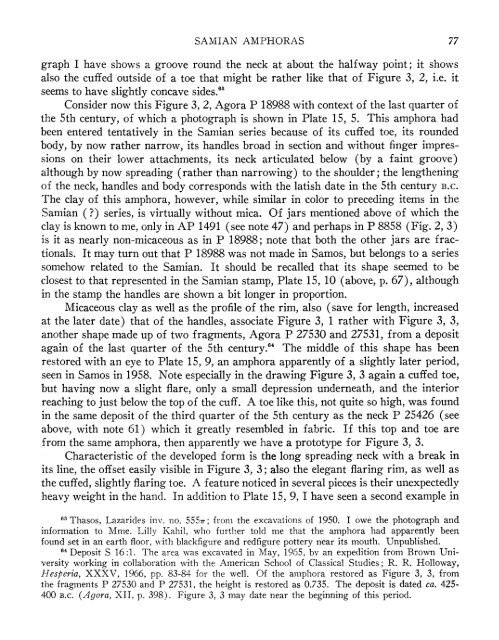SAMIAN AMPHORAS - The American School of Classical Studies at ...
SAMIAN AMPHORAS - The American School of Classical Studies at ...
SAMIAN AMPHORAS - The American School of Classical Studies at ...
You also want an ePaper? Increase the reach of your titles
YUMPU automatically turns print PDFs into web optimized ePapers that Google loves.
<strong>SAMIAN</strong> <strong>AMPHORAS</strong> 77<br />
graph I have shows a groove round the neck <strong>at</strong> about the halfway point; it shows<br />
also the cuffed outside <strong>of</strong> a toe th<strong>at</strong> might be r<strong>at</strong>her like th<strong>at</strong> <strong>of</strong> Figure 3, 2, i.e. it<br />
seems to have slightly concave sides.63<br />
Consider now this Figure 3, 2, Agora P 18988 with context <strong>of</strong> the last quarter <strong>of</strong><br />
the 5th century, <strong>of</strong> which a photograph is shown in Pl<strong>at</strong>e 15, 5. This amphora had<br />
been entered tent<strong>at</strong>ively in the Samian series because <strong>of</strong> its cuffed toe, its rounded<br />
body, by now r<strong>at</strong>her narrow, its handles broad in section and without finger impres-<br />
sions on their lower <strong>at</strong>tachments, its neck articul<strong>at</strong>ed below (by a faint groove)<br />
although by now spreading (r<strong>at</strong>her than narrowing) to the shoulder; the lengthening<br />
<strong>of</strong> the neck, handles and body corresponds with the l<strong>at</strong>ish d<strong>at</strong>e in the 5th century B.C.<br />
<strong>The</strong> clay <strong>of</strong> this amphora, however, while similar in color to preceding items in the<br />
Samian (?) series, is virtually without mica. Of jars mentioned above <strong>of</strong> which the<br />
clay is known to me, only in AP 1491 (see note 47) and perhaps in P 8858 (Fig. 2, 3)<br />
is it as nearly non-micaceous as in P 18988; note th<strong>at</strong> both the other jars are frac-<br />
tionals. It may turn out th<strong>at</strong> P 18988 was not made in Samos, but belongs to a series<br />
somehow rel<strong>at</strong>ed to the Samian. It should be recalled th<strong>at</strong> its shape seemed to be<br />
closest to th<strong>at</strong> represented in the Samian stamp, Pl<strong>at</strong>e 15, 10 (above, p. 67), although<br />
in the stamp the handles are shown a bit longer in proportion.<br />
Micaceous clay as well as the pr<strong>of</strong>ile <strong>of</strong> the rim, also (save for length, increased<br />
<strong>at</strong> the l<strong>at</strong>er d<strong>at</strong>e) th<strong>at</strong> <strong>of</strong> the handles, associ<strong>at</strong>e Figure 3, 1 r<strong>at</strong>her with Figure 3, 3,<br />
another shape made up <strong>of</strong> two fragments, Agora P 27530 and 27531, from a deposit<br />
again <strong>of</strong> the last quarter <strong>of</strong> the 5th century.64 <strong>The</strong> middle <strong>of</strong> this shape has been<br />
restored with an eye to Pl<strong>at</strong>e 15, 9, an amphora apparently <strong>of</strong> a slightly l<strong>at</strong>er period,<br />
seen in Samos in 1958. Note especially in the drawing Figure 3, 3 again a cuffed toe,<br />
but having now a slight flare, only a small depression underne<strong>at</strong>h, and the interior<br />
reaching to just below the top <strong>of</strong> the cuff. A toe like this, not quite so high, was found<br />
in the same deposit <strong>of</strong> the third quarter <strong>of</strong> the 5th century as the neck P 25426 (see<br />
above, with note 61) which it gre<strong>at</strong>ly resembled in fabric. If this top and toe are<br />
from the same amphora, then apparently we have a prototype for Figure 3, 3.<br />
Characteristic <strong>of</strong> the developed form is the long spreading neck with a break in<br />
its line, the <strong>of</strong>fset easily visible in Figure 3, 3; also the elegant flaring rim, as well as<br />
the cuffed, slightly flaring toe. A fe<strong>at</strong>ure noticed in several pieces is their unexpectedly<br />
heavy weight in the hand. In addition to Pl<strong>at</strong>e 15, 9, I have seen a second example in<br />
63 Thasos, Lazarides inv. no. 5557r; from the excav<strong>at</strong>ions <strong>of</strong> 1950. I owe the photograph and<br />
inform<strong>at</strong>ion to Mme. Lilly Kahil, who further told me th<strong>at</strong> the amphora had apparently been<br />
found set in an earth floor, with blackfigure and redfigure pottery near its mouth. Unpublished.<br />
64 Deposit S 16:1. <strong>The</strong> area was excav<strong>at</strong>ed in May, 1965, by an expedition from Brown Uni-<br />
versity working in collabor<strong>at</strong>ion with the <strong>American</strong> <strong>School</strong> <strong>of</strong> <strong>Classical</strong> <strong>Studies</strong>; R. R. Holloway,<br />
Hesperia, XXXV, 1966, pp. 83-84 for the well. Of the amphora restored as Figure 3, 3, from<br />
the fragments P 27530 and P 27531, the height is restored as 0.735. <strong>The</strong> deposit is d<strong>at</strong>ed ca. 425-<br />
400 B.C. (Agora, XII, p. 398). Figure 3, 3 may d<strong>at</strong>e near the beginning <strong>of</strong> this period.

















